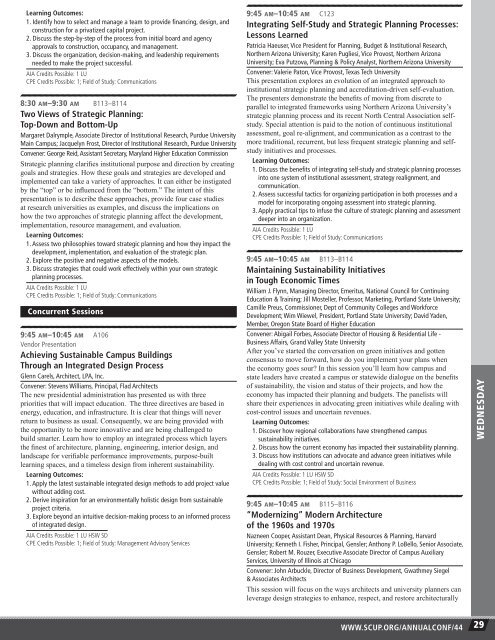Final Program - Society for College and University Planning
Final Program - Society for College and University Planning
Final Program - Society for College and University Planning
- No tags were found...
Create successful ePaper yourself
Turn your PDF publications into a flip-book with our unique Google optimized e-Paper software.
Learning Outcomes:1. Identify how to select <strong>and</strong> manage a team to provide financing, design, <strong>and</strong>construction <strong>for</strong> a privatized capital project.2. Discuss the step-by-step of the process from initial board <strong>and</strong> agencyapprovals to construction, occupancy, <strong>and</strong> management.3. Discuss the organization, decision-making, <strong>and</strong> leadership requirementsneeded to make the project successful.AIA Credits Possible: 1 LUCPE Credits Possible: 1; Field of Study: Communications8:30 am–9:30 am B113–B114Two Views of Strategic <strong>Planning</strong>:Top-Down <strong>and</strong> Bottom-UpMargaret Dalrymple, Associate Director of Institutional Research, Purdue <strong>University</strong>Main Campus; Jacquelyn Frost, Director of Institutional Research, Purdue <strong>University</strong>Convener: George Reid, Assistant Secretary, Maryl<strong>and</strong> Higher Education CommissionStrategic planning clarifies institutional purpose <strong>and</strong> direction by creatinggoals <strong>and</strong> strategies. How these goals <strong>and</strong> strategies are developed <strong>and</strong>implemented can take a variety of approaches. It can either be instigatedby the “top” or be influenced from the “bottom.” The intent of thispresentation is to describe these approaches, provide four case studiesat research universities as examples, <strong>and</strong> discuss the implications onhow the two approaches of strategic planning affect the development,implementation, resource management, <strong>and</strong> evaluation.Learning Outcomes:1. Assess two philosophies toward strategic planning <strong>and</strong> how they impact thedevelopment, implementation, <strong>and</strong> evaluation of the strategic plan.2. Explore the positive <strong>and</strong> negative aspects of the models.3. Discuss strategies that could work effectively within your own strategicplanning processes.AIA Credits Possible: 1 LUCPE Credits Possible: 1; Field of Study: CommunicationsConcurrent Sessions9:45 am–10:45 am A106Vendor PresentationAchieving Sustainable Campus BuildingsThrough an Integrated Design ProcessGlenn Carels, Architect, LPA, Inc.Convener: Stevens Williams, Principal, Flad ArchitectsThe new presidential administration has presented us with threepriorities that will impact education. The three directives are based inenergy, education, <strong>and</strong> infrastructure. It is clear that things will neverreturn to business as usual. Consequently, we are being provided withthe opportunity to be more innovative <strong>and</strong> are being challenged tobuild smarter. Learn how to employ an integrated process which layersthe finest of architecture, planning, engineering, interior design, <strong>and</strong>l<strong>and</strong>scape <strong>for</strong> verifiable per<strong>for</strong>mance improvements, purpose-builtlearning spaces, <strong>and</strong> a timeless design from inherent sustainability.Learning Outcomes:1. Apply the latest sustainable integrated design methods to add project valuewithout adding cost.2. Derive inspiration <strong>for</strong> an environmentally holistic design from sustainableproject criteria.3. Explore beyond an intuitive decision-making process to an in<strong>for</strong>med processof integrated design.AIA Credits Possible: 1 LU HSW SDCPE Credits Possible: 1; Field of Study: Management Advisory Services9:45 am–10:45 am C123Integrating Self-Study <strong>and</strong> Strategic <strong>Planning</strong> Processes:Lessons LearnedPatricia Haeuser, Vice President <strong>for</strong> <strong>Planning</strong>, Budget & Institutional Research,Northern Arizona <strong>University</strong>; Karen Pugliesi, Vice Provost, Northern Arizona<strong>University</strong>; Eva Putzova, <strong>Planning</strong> & Policy Analyst, Northern Arizona <strong>University</strong>Convener: Valerie Paton, Vice Provost, Texas Tech <strong>University</strong>This presentation explores an evolution of an integrated approach toinstitutional strategic planning <strong>and</strong> accreditation-driven self-evaluation.The presenters demonstrate the benefits of moving from discrete toparallel to integrated frameworks using Northern Arizona <strong>University</strong>’sstrategic planning process <strong>and</strong> its recent North Central Association selfstudy.Special attention is paid to the notion of continuous institutionalassessment, goal re-alignment, <strong>and</strong> communication as a contrast to themore traditional, recurrent, but less frequent strategic planning <strong>and</strong> selfstudyinitiatives <strong>and</strong> processes.Learning Outcomes:1. Discuss the benefits of integrating self-study <strong>and</strong> strategic planning processesinto one system of institutional assessment, strategy realignment, <strong>and</strong>communication.2. Assess successful tactics <strong>for</strong> organizing participation in both processes <strong>and</strong> amodel <strong>for</strong> incorporating ongoing assessment into strategic planning.3. Apply practical tips to infuse the culture of strategic planning <strong>and</strong> assessmentdeeper into an organization.AIA Credits Possible: 1 LUCPE Credits Possible: 1; Field of Study: Communications9:45 am–10:45 am B113–B114Maintaining Sustainability Initiativesin Tough Economic TimesWilliam J. Flynn, Managing Director, Emeritus, National Council <strong>for</strong> ContinuingEducation & Training; Jill Mosteller, Professor, Marketing, Portl<strong>and</strong> State <strong>University</strong>;Camille Preus, Commissioner, Dept of Community <strong>College</strong>s <strong>and</strong> Work<strong>for</strong>ceDevelopment; Wim Wiewel, President, Portl<strong>and</strong> State <strong>University</strong>; David Yaden,Member, Oregon State Board of Higher EducationConvener: Abigail Forbes, Associate Director of Housing & Residential Life -Business Affairs, Gr<strong>and</strong> Valley State <strong>University</strong>After you’ve started the conversation on green initiatives <strong>and</strong> gottenconsensus to move <strong>for</strong>ward, how do you implement your plans whenthe economy goes sour? In this session you’ll learn how campus <strong>and</strong>state leaders have created a campus or statewide dialogue on the benefitsof sustainability, the vision <strong>and</strong> status of their projects, <strong>and</strong> how theeconomy has impacted their planning <strong>and</strong> budgets. The panelists willshare their experiences in advocating green initiatives while dealing withcost-control issues <strong>and</strong> uncertain revenues.Learning Outcomes:1. Discover how regional collaborations have strengthened campussustainability initiatives.2. Discuss how the current economy has impacted their sustainability planning.3. Discuss how institutions can advocate <strong>and</strong> advance green initiatives whiledealing with cost control <strong>and</strong> uncertain revenue.AIA Credits Possible: 1 LU HSW SDCPE Credits Possible: 1; Field of Study: Social Environment of Business9:45 am–10:45 am B115–B116“Modernizing” Modern Architectureof the 1960s <strong>and</strong> 1970sNazneen Cooper, Assistant Dean, Physical Resources & <strong>Planning</strong>, Harvard<strong>University</strong>; Kenneth I. Fisher, Principal, Gensler; Anthony P. LoBello, Senior Associate,Gensler; Robert M. Rouzer, Executive Associate Director of Campus AuxiliaryServices, <strong>University</strong> of Illinois at ChicagoConvener: John Arbuckle, Director of Business Development, Gwathmey Siegel& Associates ArchitectsThis session will focus on the ways architects <strong>and</strong> university planners canleverage design strategies to enhance, respect, <strong>and</strong> restore architecturallywednesdaywww.SCUP.ORG/ANNUALCONf/44 29
















